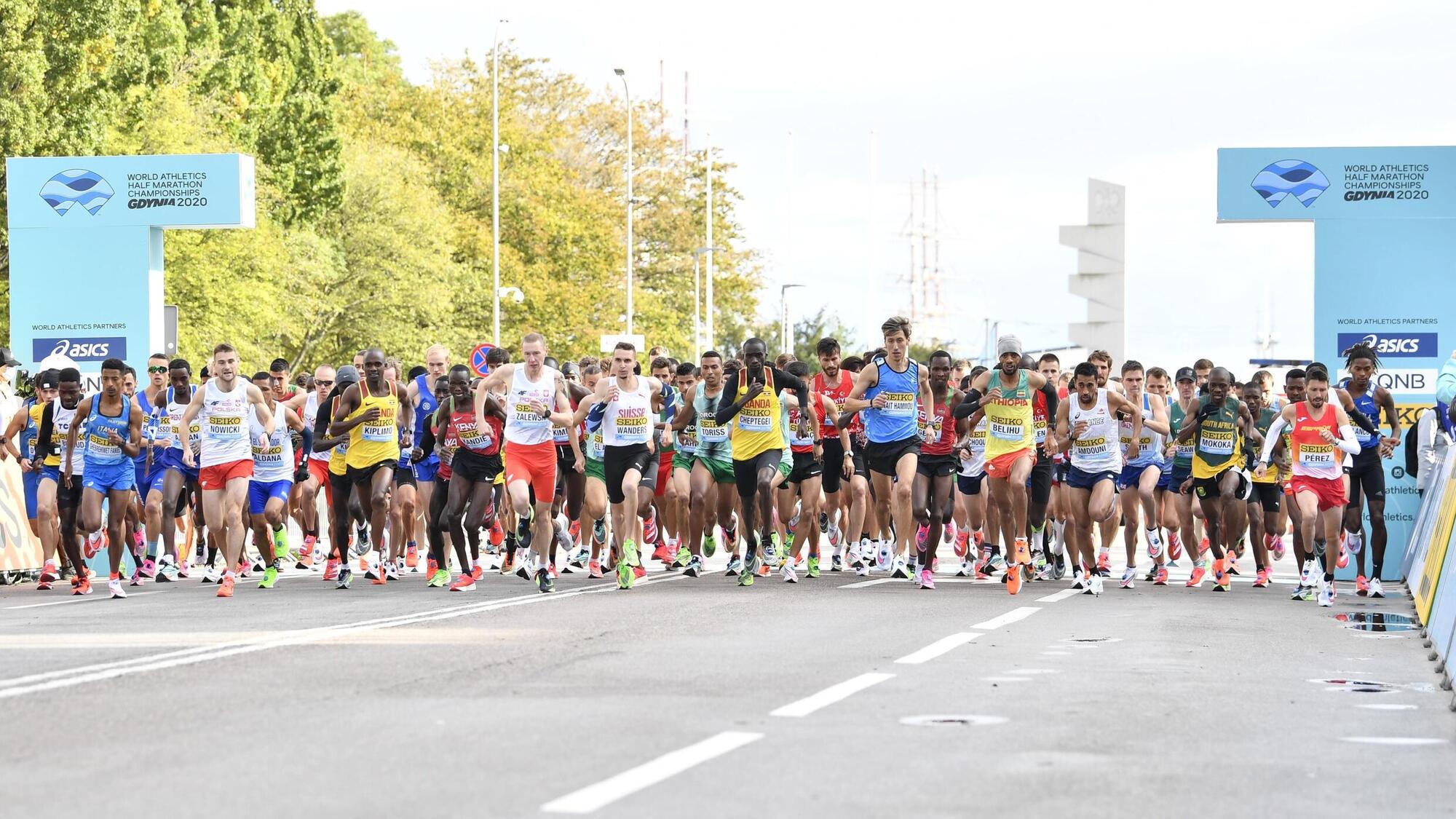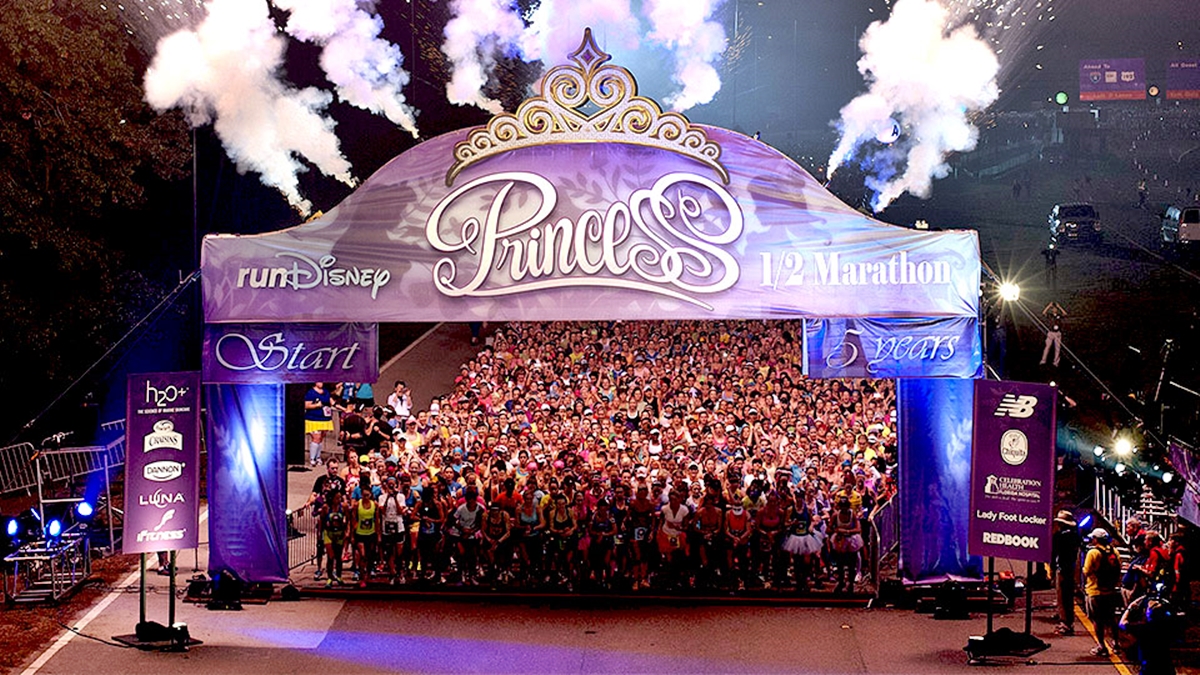

Featured
How To Prepare For Half Marathon
Modified: January 22, 2024
Prepare for your upcoming half marathon with our featured training tips and advice. Get ready to conquer the race with our expert guidance.
Introduction
Preparing for a half marathon is an exciting and challenging endeavor. Whether you are a seasoned runner or a beginner looking to take on a new fitness goal, training for a half marathon requires dedication, planning, and a well-thought-out strategy. This article will guide you through the process of preparing for a half marathon, covering everything from setting goals to race day tips.
Running a half marathon is not only a physical test but also a mental one. It requires endurance, speed, and the ability to push through challenges. By following a structured training plan, incorporating strength and cross-training exercises, and focusing on proper nutrition and rest, you can increase your chances of success on race day.
Before you begin training, it is important to set clear goals for yourself. Do you want to finish the race within a certain time? Are you aiming to improve your personal best? Or are you simply looking to complete the half marathon and enjoy the experience? By defining your goals, you can tailor your training plan accordingly and stay motivated throughout the process.
Once you have set your goals, the next step is to create a training plan. This plan will outline the duration of your training, the mileage you need to cover each week, and the specific workouts you should incorporate. It is important to gradually increase your mileage and intensity to avoid overtraining and injury.
Building endurance is a crucial aspect of half marathon training. This involves gradually increasing the distance of your long runs and incorporating regular runs at an easy, conversational pace. As your body adapts to the increased mileage, you will build the stamina necessary to complete the race.
In addition to endurance, speed and tempo training should also be included in your training plan. These workouts help improve your pace and build your cardiovascular fitness. Interval training, where you alternate between high-intensity and recovery periods, is an effective way to improve your speed.
Strength training is often overlooked in half marathon training, but it plays a vital role in preventing injuries and improving performance. Incorporating exercises that target your core, legs, and upper body will enhance your overall strength and stability.
While running is the main component of your training, cross training should also be included to improve overall fitness and reduce the risk of overuse injuries. Activities like cycling, swimming, or yoga can complement your running routine by providing cardiovascular conditioning and flexibility.
Proper nutrition is essential for fueling your training and aiding in recovery. Fueling your body with a balance of carbohydrates, protein, and healthy fats will optimize your energy levels and support muscle repair. Hydration is also crucial, so make sure to drink plenty of water before, during, and after your runs.
Rest and recovery are just as important as the training itself. Your body needs time to repair and adapt to the demands of training. Make sure to incorporate rest days into your schedule and listen to your body’s signals to avoid overtraining and burnout.
Mental preparation is often underestimated but can make all the difference on race day. Visualizing success, staying positive, and having a strong mental mindset will help you push through any challenges you may face during the race.
Lastly, on race day, be sure to pace yourself, stick to your race strategy, and enjoy the experience. Don’t forget to celebrate your accomplishment, regardless of the outcome. Remember, completing a half marathon is a significant achievement and a testament to your dedication and hard work.
Setting Your Goals
Before embarking on your half marathon training journey, it is crucial to set clear and achievable goals. Your goals will serve as a roadmap, providing you with direction and motivation throughout your training. Here are some key considerations when setting your goals:
Time-based goals: One common goal for many runners is to complete the half marathon within a certain time frame. Whether it’s finishing in under two hours, achieving a personal best, or simply crossing the finish line, having a time-based goal can provide a tangible target to work towards.
Performance goals: In addition to time-based goals, you may have performance-related goals such as improving your endurance, increasing your speed, or running a negative split (running the second half of the race faster than the first). These goals focus on pushing your limits and improving your overall running abilities.
Enjoyment goals: Running a half marathon is not just about achieving specific times or performance milestones. It’s also about enjoying the journey and the experience. Your goal may be to embrace the training process, appreciate the beautiful scenery along the race route, or simply have fun and enjoy the atmosphere of the event.
When setting your goals, it’s important to make them challenging yet attainable. Setting goals that are too easy may not provide the motivation you need to push yourself, while setting goals that are too difficult may lead to frustration and disappointment. Consider your current fitness level, past running experience, and any limitations you may have. Be realistic about what you can achieve within the given timeframe.
It’s also important to keep your goals flexible. As you progress through your training, you may find that your initial goals need to be adjusted. Listen to your body and be willing to modify your goals if necessary. Remember, the most important thing is to stay committed and enjoy the process.
To hold yourself accountable and track your progress, write down your goals and break them down into smaller milestones. This will help you stay focused and motivated throughout your training. Celebrate each milestone you achieve, no matter how small, as it brings you closer to your ultimate goal.
Lastly, don’t compare your goals to others. Each runner is unique, and everyone has their own journey. Your goals should be personal and reflective of your own aspirations and abilities. Embrace your own progress and be proud of what you accomplish.
By setting clear and realistic goals, you will have a clear sense of purpose and motivation as you embark on your half marathon training journey. Remember to stay focused, stay committed, and enjoy the process. The journey towards your goal is just as important as crossing the finish line on race day.
Creating a Training Plan
Once you have set your goals for the half marathon, the next step is to create a training plan that will guide you towards success. A well-designed training plan is essential for building your endurance, improving your speed, and reducing the risk of injury. Here are some key steps to consider when creating your training plan:
Assess your current fitness level: Before diving into your training, it’s important to assess your current fitness level. Determine how many days a week you can commit to running and the total weekly mileage you are comfortable with. This will help you structure your plan accordingly and make any necessary adjustments.
Establish your weekly mileage: Gradual progression is key to prevent overtraining and injury. Start with a comfortable base mileage and gradually increase your weekly mileage by no more than 10% each week. This allows your body to adapt to the increased demands of training.
Plan your long runs: Long runs are a crucial component of half marathon training. They build your endurance and help prepare your body for the distance of the race. Gradually increase the distance of your long runs each week, aiming to reach the full half marathon distance at least once before race day.
Incorporate different types of runs: A well-rounded training plan includes a variety of runs, including easy runs, tempo runs, speed work, and recovery runs. Easy runs should make up the majority of your training, allowing your body to recover and build endurance. Tempo runs and speed work help improve your pace and build cardiovascular fitness.
Include cross-training and strength workouts: In addition to running, incorporate cross-training activities such as cycling, swimming, or yoga into your training plan. These activities provide cardiovascular conditioning and help prevent overuse injuries. Strength training is also important to improve overall strength and stability, reducing the risk of injury.
Rest and recovery: Rest days are just as important as your training days. They give your body time to recover and rebuild, preventing burnout and overtraining. Schedule regular rest days throughout your training plan, and listen to your body when it signals the need for extra rest or recovery.
Be flexible: A training plan is a guide, but it is important to be flexible and adjust as needed. Life happens, and sometimes you may need to modify your training schedule. Don’t be too hard on yourself if you miss a run or need to switch up your plan. Remember that consistency over time is more important than a rigid adherence to a plan.
It’s also beneficial to seek guidance from experienced runners or a running coach when creating your training plan. They can provide valuable insights and help tailor the plan to your specific needs and goals.
As you progress through your training plan, keep track of your workouts, mileage, and any adjustments you make along the way. This will allow you to assess your progress and make any necessary modifications to ensure you stay on track and continue to improve.
Creating a comprehensive training plan will set you up for success in your half marathon journey. By structuring your training to gradually increase mileage, incorporating different types of runs, cross-training, and rest, you will be well-prepared for the physical and mental challenges of the race. Remember to stay consistent, listen to your body, and enjoy the journey towards your goal.
Building Endurance
Building endurance is a critical component of half marathon training. It involves gradually increasing your stamina and the distance you can comfortably run, allowing you to tackle the full half marathon distance with confidence. Here are some essential tips to help you build endurance effectively:
Start with a solid base: Before increasing your mileage, it’s important to establish a solid running base. This means being able to comfortably run for at least 30 minutes without feeling overly fatigued. Once you can consistently complete this base run, you can begin to focus on increasing your distance.
Gradual mileage increase: One of the key principles of building endurance is gradual progression. Increase your weekly mileage by no more than 10% each week to allow your body to adapt to the increased demands of running longer distances. This gradual approach will help prevent injury and ensure sustainable progress.
Long runs: Long runs are essential for building endurance. Once a week, designate a day for your long runs and gradually increase the distance over time. Aim to reach the full half marathon distance at least once before race day. These long runs help condition your body to handle the sustained effort required for the race.
Easy, conversational pace: During your long runs and easy runs, focus on maintaining a conversational pace. This means running at a comfortable speed where you can hold a conversation without feeling breathless. Running at an easy pace allows your body to adapt to the increased mileage while still recovering and building endurance.
Hill training: Incorporating hill workouts into your training regimen can improve your endurance and strengthen your leg muscles. Find a hill that is challenging but manageable and perform repetitions of uphill runs. This type of training helps build both muscular and cardiovascular endurance, preparing you for the rolling terrains that you may encounter during the half marathon.
Interval training: Interval training involves alternating between higher intensity intervals and recovery periods. This type of workout improves your cardiovascular fitness and helps you sustain a faster pace for longer periods. Incorporate intervals into your training program to enhance your endurance and race pace.
Mix in cross-training: Cross-training activities such as cycling, swimming, or using an elliptical machine can complement your running routine and provide a cardiovascular workout without the impact of running. These activities help improve your overall endurance and reduce the risk of overuse injuries.
Recovery and rest: Building endurance requires consistent training, but it is equally important to prioritize rest and recovery. Listen to your body and take scheduled rest days to allow your muscles to repair and rebuild. Recovery also includes proper nutrition, hydration, and getting enough quality sleep to support your training efforts.
Remember that building endurance takes time and patience. Be diligent in following your training plan, and trust the process. Celebrate each milestone and pay attention to the improvements you make along the way. As your endurance increases, you will feel stronger and more confident in your ability to conquer the half marathon distance.
Speed and Tempo Training
To improve your race pace and overall performance in a half marathon, incorporating speed and tempo training into your routine is crucial. These types of workouts help increase your speed, build your cardiovascular fitness, and improve your body’s ability to sustain a faster pace for longer periods. Here are some key factors to consider when incorporating speed and tempo training into your half marathon training plan:
Understanding the difference: Speed training and tempo training are distinct but complementary types of workouts. Speed training involves shorter, more intense intervals at a near-maximum effort. These intervals help improve your anaerobic capacity, leg turnover, and running form. Tempo training, on the other hand, involves sustained efforts at a comfortably-hard pace, just slightly below your maximum effort. This helps improve your lactate threshold and teaches your body to sustain a faster pace for longer periods.
Interval training: Intervals are a key component of speed training. Incorporate shorter intervals, such as 400 meters or 800 meters, into your workouts. Run at a fast pace for the designated distance, followed by a recovery period of slow jogging or walking. Repeat the interval several times, gradually increasing the number of repetitions as you progress.
Fartlek training: Fartlek, or “speed play,” training involves alternating between periods of fast running and slower recovery periods. This type of training can be done spontaneously during a regular run or as a structured workout. Adapt the intensity and duration of the faster segments to fit your fitness level and goals.
Tempo runs: Tempo runs are an essential component of tempo training. These runs are done at a consistent, comfortably-hard pace for a sustained period. Begin with shorter tempo runs and gradually increase the duration as you progress. Tempo runs improve your lactate threshold, making it easier for your body to clear lactate and sustain a faster pace for a longer duration.
Hill repeats: Incorporating hill repeats into your speed and tempo training helps build both strength and speed. Look for a hill with a challenging incline and incorporate hill repeats into your workout. Run up the hill at a faster pace, focusing on maintaining good form and strong effort. Recover by jogging or walking back down the hill and repeat the ascent several times.
Maintaining proper form: Speed and tempo training require proper running form to maximize efficiency and reduce the risk of injury. Focus on maintaining an upright posture, engaging your core, and driving your arms forward and backward in a controlled manner. Avoid excessive tension and stride lengthening, as this can lead to inefficiency and increased injury risk.
Consistency and progression: Consistency is key when incorporating speed and tempo training into your routine. Schedule these workouts into your training plan at least once a week, gradually increasing the intensity and duration as your fitness improves. Be patient and avoid pushing yourself too hard too soon, as this can lead to burnout or injury.
Recovery and rest: Speed and tempo training can be physically demanding on your body. Allow for proper recovery and rest days in your training plan to give your muscles time to repair and adapt. This will optimize your performance and reduce the risk of overtraining or injury.
By incorporating speed and tempo training into your half marathon training plan, you will see improvements in your race pace, endurance, and overall performance. Remember to be consistent, progress gradually, and listen to your body. With dedication and the right mindset, you will be well on your way to achieving your goals in the half marathon.
Strength Training
While running is the foundation of half marathon training, incorporating strength training into your routine is crucial for improving performance and reducing the risk of injury. Strength training helps build overall strength, stability, and muscle endurance, which can greatly benefit your running efficiency and longevity. Here are some key considerations when incorporating strength training into your half marathon training plan:
Targeted muscle groups: Focus on strengthening the muscles that are essential for running, including your core (abdominal and lower back muscles), legs (quadriceps, hamstrings, calves), and upper body (arms, shoulders, and back). A well-rounded strength training program will help you maintain proper running form, improve power, and reduce imbalances.
Bodyweight exercises: Bodyweight exercises are an effective and accessible way to build strength without the need for equipment. Incorporate exercises such as squats, lunges, push-ups, planks, and mountain climbers into your routine. These exercises target multiple muscle groups simultaneously and improve overall body strength.
Resistance training: Utilize resistance bands, free weights, or weight machines to add resistance and increase the challenge of your strength training exercises. This will help improve muscle strength and endurance. Focus on exercises like deadlifts, kettlebell swings, step-ups, and shoulder presses to target specific muscle groups.
Core exercises: A strong core is essential for maintaining stability and efficient movement while running. Include exercises that target your abdominals, obliques, and lower back, such as planks, Russian twists, and Superman poses. Balancing exercises, such as single-leg squats or standing on one leg, also engage your core muscles.
Balance and stability: Incorporate exercises that challenge your balance and stability, as they help improve proprioception and prevent injuries. Include exercises like single-leg squats, standing heel-to-toe, or Bosu ball exercises to enhance your balance and stability while running.
Proper form and technique: It’s essential to ensure proper form and technique while performing strength training exercises. This reduces the risk of injury and maximizes the effectiveness of the workout. If you are unsure about proper form, consider working with a qualified fitness professional or personal trainer.
Frequency and consistency: Aim to incorporate strength training into your routine at least two to three times per week. Consistency is key, so make it a regular part of your training plan. Be mindful of not overdoing it – allow for proper recovery days in between strength training sessions to give your muscles time to rest and repair.
Balance with running: While strength training is crucial, it’s also important to find the right balance with your running workouts. Ensure that your strength training sessions do not interfere with your running sessions or leave you excessively fatigued. Adjust the intensity and timing of each workout to effectively manage both aspects of your training.
Remember that strength training is a long-term investment in your running performance and injury prevention. It may not yield immediate results, but with consistency and dedication, you will notice improvements in your strength, endurance, and overall running abilities. Tailor your strength training program to fit your specific needs and goals, and enjoy the benefits it brings to your half marathon training journey.
Cross Training
Incorporating cross training into your half marathon training plan can be highly beneficial for improving overall fitness, preventing overuse injuries, and providing variety in your workouts. Cross training involves engaging in different forms of exercise other than running to complement and enhance your training. Here are some key considerations when incorporating cross training into your half marathon training:
Benefits of cross training: Cross training offers numerous benefits, including improved cardiovascular fitness, increased muscular strength and endurance, enhanced flexibility, and reduced risk of overuse injuries. Engaging in different activities helps target different muscle groups and reduces the repetitive strain on the same muscles and joints caused by running.
Choose suitable activities: Select cross training activities that are low-impact to complement your running workouts. Cycling, swimming, elliptical training, rowing, and yoga are great options to boost cardiovascular fitness, strengthen different muscles, and improve flexibility without subjecting your body to excessive stress and impact.
Cross train on rest days: Incorporate cross training activities on the days you have designated for rest or light recovery runs. This allows you to maintain an active lifestyle while giving your running muscles time to recover. Engaging in a different activity can also help mentally refresh you from running and prevent burnout.
Intensity and duration: The intensity and duration of your cross-training sessions should be tailored to your fitness level and training goals. Aim for moderate-intensity workouts that elevate your heart rate and challenge different muscles. Gradually increase the duration and intensity as your fitness improves.
Strength and conditioning: Include strength and conditioning exercises in your cross training routine to target muscle groups not primarily engaged during running. Bodyweight exercises, resistance training, or using machines can help strengthen your core, legs, and upper body, enhancing overall stability and running performance.
Work on flexibility and mobility: Add flexibility and mobility-focused activities such as yoga, Pilates, or stretching routines to your cross training plan. These activities improve flexibility, range of motion, and joint mobility, leading to better running form and reduced risk of injuries.
Keep it enjoyable: Choose cross training activities that you enjoy and look forward to. Whether it’s dancing, hiking, playing a sport, or taking a dance class, finding activities that bring you joy can help you stay motivated throughout your half marathon training journey.
Listen to your body: Pay attention to how your body responds to cross training activities. If you experience pain or discomfort, modify or switch to a different activity. Cross training should enhance your running performance, not hinder it. Be mindful of not overtraining or neglecting adequate rest and recovery.
Be consistent: Strive for consistency by incorporating cross training into your training plan on a regular basis. Aim for two to three cross training sessions per week, depending on your running schedule and overall fitness level. Consistency is key to reaping the benefits of cross training.
Incorporating cross training into your half marathon training plan allows you to build overall fitness, reduce the risk of injuries, and add variety to your routine. Select activities that complement running, listen to your body, and enjoy the benefits that cross training brings to your running journey.
Proper Nutrition
Proper nutrition plays a crucial role in fueling your body for half marathon training and optimizing your performance on race day. The food you consume provides the energy, nutrients, and hydration necessary to support your training, aid in recovery, and keep you in peak condition. Here are some key considerations for maintaining proper nutrition during your half marathon training:
Eat a balanced diet: Aim for a well-rounded diet that includes a balance of carbohydrates, protein, and healthy fats. Carbohydrates provide the primary source of energy for running, while protein supports muscle repair and growth. Healthy fats help with vitamin absorption and provide long-lasting energy.
Carbohydrates: Incorporate complex carbohydrates into your meals such as whole grains, fruits, vegetables, and legumes. These provide sustained energy, steady blood sugar levels, and necessary fiber. Prioritize carbohydrates in the form of whole foods rather than relying heavily on processed or refined sources.
Protein: Consume adequate protein to support muscle recovery and growth. Include lean sources of protein such as chicken, turkey, fish, eggs, tofu, legumes, and Greek yogurt. Aim for a balance of plant and animal-based proteins, considering personal dietary preferences and needs.
Healthy fats: Include sources of healthy fats in your diet, such as avocados, nuts, seeds, olive oil, and fatty fish like salmon. These provide essential fatty acids, which support brain function and reduce inflammation. Avoid saturated and trans fats, commonly found in processed and fried foods.
Hydration: Stay well-hydrated throughout your training. Proper hydration is essential for maintaining energy levels, regulating body temperature, and aiding in recovery. Drink water consistently throughout the day, and consider adding electrolyte-rich beverages during longer runs or strenuous workouts.
Pre-run fueling: Consume a balanced meal or snack containing carbohydrates and a moderate amount of protein before longer training runs. Aim to eat about one to three hours before your run to allow for proper digestion and minimize discomfort.
Post-run recovery: Refuel your body with a combination of carbohydrates and protein within 30 to 60 minutes after your run. This helps replenish glycogen stores, repair muscles, and enhance recovery. A snack or meal that includes a source of carbohydrates and lean protein, such as a turkey sandwich or a protein smoothie with fruit, can be beneficial.
Meal planning and timing: Plan your meals and snacks in advance to ensure you have proper nutrition readily available. Fuel your body with regular, balanced meals and snacks throughout the day to maintain consistent energy levels. Pay attention to portion sizes and listen to your body’s hunger and fullness cues.
Vitamins and minerals: Focus on obtaining essential vitamins and minerals through a varied and colorful diet. Prioritize whole foods such as fruits, vegetables, whole grains, and nuts, which provide a wide range of nutrients necessary for optimal health and performance.
Individual needs: Everyone’s nutritional needs vary. Pay attention to how your body responds to different foods and adjust your diet accordingly. Consulting with a registered dietitian or nutritionist can provide personalized guidance and ensure you’re meeting your nutritional requirements for half marathon training.
Remember, proper nutrition is not just about race day but should be a consistent focus throughout your training journey. By fueling your body with the right balance of nutrients, you’ll optimize your performance, enhance recovery, and support overall health and well-being during your half marathon training.
Rest and Recovery
Rest and recovery are often overlooked but crucial aspects of half marathon training. While consistent training is important, it is during periods of rest that your body repairs and adapts, leading to improved performance and reduced risk of injury. Here are some key considerations for incorporating proper rest and recovery into your half marathon training plan:
Schedule regular rest days: Rest days should be an integral part of your training plan. These days allow your muscles to repair and rebuild, reducing the risk of overuse injuries. While it may be tempting to push through and train every day, giving your body regular breaks is essential for long-term progress.
Listen to your body: Pay attention to the signals your body sends you. If you’re feeling excessively fatigued, sore, or if you experience any pain or discomfort, it’s a sign that you may need extra rest. Be mindful of any warning signs of overtraining and adjust your training accordingly.
Sleep: Quality sleep is essential for optimal recovery. Aim for 7-9 hours of sleep per night, as it plays a vital role in muscle repair, hormone regulation, and overall well-being. Create a consistent sleep routine and prioritize a good sleep environment to ensure restful sleep.
Nutrition and hydration: Proper nutrition and hydration support your body’s recovery process. Refuel with nutritious, balanced meals and hydrate adequately throughout the day. Include a source of carbohydrates and protein in your post-workout nutrition to replenish glycogen stores and support muscle repair.
Active recovery: Engage in activities that promote active recovery on your rest days, such as gentle stretching, yoga, or low-impact cross-training. These activities help improve blood circulation, maintain mobility, and promote relaxation without placing additional stress on your body.
Self-care practices: Incorporate self-care activities into your routine to manage stress and promote overall well-being. This can include activities like meditation, deep breathing exercises, foam rolling, or taking a relaxing bath. These practices can aid in muscle recovery and reduce mental stress.
Periodization: Incorporating planned periods of reduced intensity or volume, known as “deload” weeks or rest weeks, can be beneficial. These periods allow for a more significant recovery and help prevent burnout and overtraining. Plan these deload weeks strategically throughout your training plan.
Gradual buildup: Avoid sudden spikes in training volume or intensity, as this can lead to overuse injuries and exhaustion. Gradually increase your mileage and intensity to allow your body to adapt and recover effectively from each training session.
Stress management: Training for a half marathon can be physically and mentally demanding. Implement stress management techniques such as deep breathing, meditation, or engaging in activities you enjoy outside of running. Taking care of your mental well-being is as important as the physical aspect of training.
Monitor recovery metrics: Pay attention to recovery metrics such as resting heart rate, sleep quality, muscle soreness, and overall energy levels. This can provide insight into your recovery status and help you make informed decisions about training intensity and rest days.
Remember, rest and recovery are not signs of weakness but rather crucial components of a successful and sustainable half marathon training journey. Prioritize rest, listen to your body, and embrace the rejuvenating benefits that come from allowing your body the time it needs to recover.
Mental Preparation
Preparing mentally for a half marathon is just as important as the physical training. The mental aspect of running plays a significant role in determining your success on race day. Here are some key strategies to help you develop mental resilience and prepare yourself for the challenges that lie ahead:
Goal visualization: Visualize yourself crossing the finish line, accomplishing your goals, and achieving success. Create a clear mental image of what you want to accomplish, and regularly visualize yourself running strong and confidently during your training runs and on race day.
Positive self-talk: Develop a positive internal dialogue and replace self-doubt and negative thoughts with positive affirmations. Replace negative thoughts with statements like “I am strong,” “I can do this,” and “I am prepared.” Train your mind to focus on the positive aspects of your training journey.
Mindfulness and present moment awareness: Practice mindfulness techniques during your training runs to stay focused and present. Pay attention to your breath, the sensation of your feet hitting the ground, and the sound of your surroundings. Being present in the moment can help you stay calm and centered during the race.
Develop a mantra: Create a personal mantra or phrase that resonates with you and helps you stay motivated and focused during challenging moments. Repeat this mantra during your training runs to anchor positive emotions and recite it when faced with difficulties during the race.
Stay flexible and adapt: Half marathons don’t always go as planned. Be prepared to adapt and adjust your expectations or race strategy if unforeseen circumstances arise. Instead of getting discouraged, embrace the flexibility and see it as an opportunity to challenge yourself and grow as a runner.
Break it down: Instead of focusing on the entire distance, break the race down into smaller, more manageable segments. Set mini-goals for each section of the race, such as reaching the halfway point or conquering a challenging hill. Focusing on these smaller milestones can help you stay motivated and mentally strong.
Train your mental resilience: Include mental resilience exercises in your training routine. Incorporate challenging training runs, simulate race day scenarios, and practice coping strategies for fatigue and discomfort. Embrace discomfort during your training so that you are better prepared to handle it during the race.
Draw motivation from others: Surround yourself with a supportive network of fellow runners or a running community. Drawing inspiration from others, sharing your experiences, and receiving encouragement can provide an added mental boost and motivation.
Have a race day plan: Prepare a race day plan that includes your pacing strategy, fueling/hydration plan, and mentally rehearsing different scenarios. Knowing that you have a well-thought-out plan can instill confidence and reduce pre-race anxiety.
Embrace the journey: Remember that running a half marathon is not just about the race day itself but also about the entire training journey. Embrace the ups and downs, the small victories, and the lessons learned along the way. Cultivate gratitude for the experience and enjoy the process as much as the outcome.
By incorporating these mental preparation strategies into your training routine, you can develop the mental resilience and focus needed to conquer the challenges of the half marathon. Train your mind just as you train your body, and you will be well-equipped to achieve your goals and enjoy the race day experience to the fullest.
Race Day Tips
Race day is the culmination of all your hard work and preparation. To ensure a successful and enjoyable half marathon experience, here are some key tips to keep in mind on race day:
Stick to your routine: Stick to your pre-race routine as much as possible. Wake up at the same time, eat a familiar breakfast, and follow your usual warm-up routine. This helps minimize any surprises or disruptions to your body on race day.
Arrive early: Arrive at the race venue with ample time. This allows you to familiarize yourself with the surroundings, use the facilities, and mentally prepare for the race. Give yourself enough time to go through any necessary pre-race procedures, such as picking up your bib number or using gear check-in.
Warm up: Warm up your body with a dynamic warm-up routine that includes light jogging, dynamic stretches, and strides. This helps prepare your muscles for the race and increases blood flow to key areas.
Start slow: Avoid the temptation to start too fast. Begin the race at a comfortable and sustainable pace. Adrenaline can make you feel invincible at the start, but going out too fast can lead to burnout later on. Build your speed as the race progresses.
Stick to your race plan: Stick to the pacing and fueling strategy you have planned during your training. Trust in your preparation and avoid making sudden changes on race day. This helps you stay in control and maintain a consistent effort throughout the race.
Hydrate and fuel strategically: Stay well-hydrated throughout the race by taking advantage of water stations along the course. If you have practiced with energy gels or sports drinks during training, use them strategically to replenish electrolytes and maintain energy levels. Don’t try anything new on race day to avoid potential digestive issues.
Maintain mental focus: Stay mentally engaged throughout the race. Focus on your form, your breathing, and your surroundings. Break the race down into smaller sections and set mini-goals to stay motivated and maintain mental resilience.
Use crowd support: Embrace the energy and support from spectators along the course. Their cheers and encouragement can provide a significant boost to your morale. Smile, high-five spectators, and acknowledge their presence to help keep your spirits high.
Stay positive: Maintain a positive mindset, especially during challenging moments. Use positive self-talk, focus on your strengths, and remind yourself of how far you have come. Replace any negative thoughts with empowering phrases to lift your spirits and keep you motivated.
Enjoy the experience: Half marathons are about more than just the finish line. Take the time to soak in the atmosphere, admire the scenery, and appreciate the accomplishment of running a half marathon. Smile, have fun, and celebrate your journey.
Celebrate your achievement: Once you cross that finish line, take a moment to celebrate your achievement. Reflect on the hard work and dedication you put into training and bask in the sense of accomplishment. Be proud of what you have accomplished, regardless of your finishing time.
Remember, race day is the culmination of weeks or even months of training. Trust in your preparation, stay focused, and enjoy the experience. You have prepared well, and now it’s time to put your training into action and celebrate your achievement as you complete your half marathon journey.
Conclusion
Congratulations! You have now gained a thorough understanding of how to prepare for a half marathon. From setting your goals and creating a training plan to building endurance, incorporating speed and tempo training, strength training, cross training, proper nutrition, rest and recovery, mental preparation, and race day tips, you are equipped with the knowledge and strategies needed for a successful half marathon journey.
Remember, half marathon training requires dedication, perseverance, and consistency. It is a challenging but rewarding endeavor that tests your physical and mental limits. Stay committed to your goals, listen to your body, and make adjustments as needed along the way.
Throughout your training, always prioritize your health and well-being. Pay attention to rest and recovery, fuel your body with the right nutrition, and practice self-care. Your body and mind need time to recuperate and adapt to the demands of training.
On race day, trust in your training and have confidence in your abilities. Stay focused, embrace the energy of the crowd, and enjoy the experience. Remember that crossing the finish line is an incredible accomplishment, regardless of your finishing time. Celebrate your achievement and reflect on the hard work you put into reaching this milestone.
Whether it is your first half marathon or you are an experienced runner, completing a half marathon is a testament to your determination and the strength of your spirit. Cherish the journey and the personal growth that comes along with it.
Now, go out there, lace up your shoes, and embark on your half marathon adventure. Push your limits, embrace the challenges, and revel in the joy of crossing that finish line. You are capable, you are prepared, and you are ready to conquer the half marathon!









